#late archaic
Explore tagged Tumblr posts
Text

~ Plaque.
Culture: Italic, Etruscan
Period: Late Archaic Period or early Classical Period
Date: ca. 470 B.C.
Medium: Terracotta
#ancient#ancient art#history#museum#archeology#ancient history#archaeology#plaque#music#musician#etruscan#italic#late archaic#early Classical period#terracotta#ca. 470 b.c.
4K notes
·
View notes
Text



AN ETRUSCAN LARGE BRONZE VOTIVE FIGURE OF A KORE LATE ARCHAIC, CIRCA 480 B.C.
Striding with her left foot forward and both forearms extended, a pomegranate in her left hand, a fragmentary flower in her right hand, and wearing boots with central tab, chiton with wavy pleats, and long close-fitting himation draped over the right shoulder and falling down the lower back, the neck of the chiton and hem of the himation with cross-hatched decoration, her hair radiating from the crown and bound and rolled up in a twisted fillet, the details finely engraved. Height without tenons 21.4 cm.
#AN ETRUSCAN LARGE BRONZE VOTIVE FIGURE OF A KORE#LATE ARCHAIC#CIRCA 480 B.C.#bronze#bronze statue#bronze sculpture#ancient artifacts#archeology#archeolgst#history#history news#ancient history#ancient culture#ancient civilizations#ancient art#etruscan history#etruscan art
75 notes
·
View notes
Text
"Odysseus never once cheated on his wife!" wrong "Odysseus spent 10 years slutting it up around the Mediterranean sleeping around with every women he met" also wrong. can we move on now
#We can debate how consensual his relationships with Circe and Calypso were#We can also point out the implications of his 'prize' in the Iliad and the women of Ismarus in the Odyssey#We could also probably talk about Archaic Greek gender norms and relationship expectations#AND what assumptions Archaic Greek people were making about Late Bronze Age gender norms and relationship expectations#Plus the roles of both royalty and slavery and the difference between 'fair' slavery/captivity and 'unfair' slavery/captivity#however. apparently Odysseus Cheating Discourse never ends#The Odyssey
34 notes
·
View notes
Note

dmc you say
DAMMMMMM i am still pretty early in but ooh. oooh baby i am about to become Insufferable About That Man i can Feel It thank you for adding another white haired man to my arsenal <3
#wait hold on i just remembered i have to finally publish that ask you sent me abt dmc like 2 years ago that ive been saving#for when i finally play dmc#danswers#dmc#scalproie#had to stop playing bc its very late (early) and i need to get some sleep but im having a blast#im still only on dmc1 so i am really enjoying it whenever im not frustrated with the archaic camera but ill get used to it eventually#so far dmc1 is VERY re4 which is cool but im very excited to see how it develops into its own series
5 notes
·
View notes
Text
they should get falcom to do something with the dunmesh ip. like not a straight adaptation but some kinda CRPG spinoff.
#ideally with trails in the sky style prerendered models#and whatever archaic gameplay nonsense that kui happens to have an affinity for#but we're like 20 years too late for that sadly#they could also get the divinity/baldur's gate people to do it#since they ended the manga by releasing bg3
11 notes
·
View notes
Note
Hi Dr Reames!
Would you say that Macedon shared the same "political culture" with its Thracian and Illyrian neighbours, like how most Greeks shared the polis structure and the concept of citizenship?
I don't really know anything about Macedonian history before Philip II's time, but you've often brought up how the Macedonians shared some elements of elite culture (e.g. mound burials) with their Thracian neighbours, as well religious beliefs and practices.
I've only ever heard these people generically described as "a collection of tribes (that confederated into a kingdom)", which also seems to be the common description for nearby "Greek" polities like Thessaly and Epiros. So did these societies have a lot in common, structurally speaking, with Macedon? Or were they just completely different types of polities altogether?
First, in the interest of some good bibliography on the Thracians:
Z. H. Archibald, The Odrysian Kingdom of Thrace. Orpheus Unmasked. Oxford UP, 1998. (Too expensive outside libraries, but highly recommended if you can get it by interlibrary loan. Part of the exorbitant cost [almost $400, but used for less] owes to images, as it’s archaeology heavy. Archibald is also an expert on trade and economy in north Greece and the Black Sea region, and has edited several collections on the topic.
Alexander Fol, Valeria Fol. Thracians. Coronet Books, 2005. Also expensive, if not as bad, and meant for the general public. Fol’s 1977 Thrace and the Thracians, with Ivan Marazov, was a classic. Fol and Marazov are fathers of modern Thracian studies.
R. F. Hodinott, The Thracians. Thames and Hudson, 1981. Somewhat dated now but has pictures and can be found used for a decent price if you search around. But, yeah…dated.
For Illyria, John Wilkes’ The Illyrians, Wiley-Blackwell, 1996, is a good place to start, but there’s even less about them in book form (or articles).
—————
Now, to the question.
BOTH the Thracians and Illyrians were made up of politically independent tribes bound by language and religion who, sometimes, also united behind a strong ruler (the Odrysians in Thrace for several generations, and Bardylis briefly in Illyria). One can probably make parallels to Germanic tribes, but it’s easier for me to point to American indigenous nations. The Odrysians might be compared to the Iroquois federation. The Illyrians to the Great Lakes people, united for a while behind Tecumseh, but not entirely, and disunified again after. These aren’t perfect, but you get the idea. For that matter, the Greeks themselves weren’t a nation, but a group of poleis bonded by language, culture, and religion. They fought as often as they cooperated. The Persian invasion forced cooperation, which then dissolved into the Peloponnesian War.
Beyond linguistic and religious parallels, sometimes we also have GEOGRAPHIC ones. So, let me divide the north into lowlands and highlands. It’s much more visible on the ground than from a map, but Epiros, Upper Macedonia, and Illyria are all more alike, landscape-wise, than Lower Macedonia and the Thracian valleys. South of all that, and different yet again, lay Thessaly, like a bridge between Southern Greece and these northern regions.
If language (and religion) are markers of shared culture, culture can also be shaped by ethnically distinct neighbors. Thracians and Macedonians weren’t ethnically related, yet certainly shared cultural features. Without falling into colonialist geographical/environmental determinism, geography does affect how early cultures develop because of what resources are available, difficulties of travel, weather, lay of the land itself, etc.
For instance, the Pindus Range, while not especially high, is rocky and made a formidable barrier to easy east-west travel. Until recently, sailing was always more efficient in Greece than travel by land (especially over mountain ranges).* Ergo, city-states/towns on the western coast tended to be western-facing for trade, and city-states/towns on the eastern side were, predictably, eastern-facing. This is why both Epiros and Ainai (Elimeia) did more trade with Corinth than Athens, and one reason Alexandros of Epiros went west to Italy while Alexander of Macedon looked east to Persia. It’s also why Corinth, Sparta, etc., in the Peloponnese colonized Sicily and S. Italy, while Athens, Euboia, etc., colonized the Asia Minor and Black Sea coasts. (It’s not an absolute, but one certainly sees trends.)
So, looking at their land, we can see why Macedonians and Thracians were both horse people with their wide valleys. They also practiced agriculture, had rich forests for logging, and significant metal (and mineral) deposits—including silver and gold—that made mining a source of wealth. They shared some burial customs but maintained acute differences. Both had lower status for women compared to Illyria/Epiros/Paionia. Yet that’s true only of some Thracian tribes, such as the Odrysians. Others had stronger roles for women. Thracians and Macedonians shared a few deities (The Rider/Zis, Dionysos/Zagreus, Bendis/Artemis/Earth Mother), although Macedonian religion maintained a Greek cast. We also shouldn’t underestimate the impact of Greek colonies along the Black Sea coast on inland Thrace, especially the Odrysians. Many an Athenian or Milesian (et al.) explorer/merchant/colonist married into the local Thracian elite.
Let’s look at burial customs, how they’re alike and different, for a concrete example of this shared regional culture.
First, while both Thracians and Macedonians had shrines, neither had temples on the Greek model until late, and then largely in Macedonia. Their money went into the ground with burials.
Temples represent a shit-ton of city/community money plowed into a building for public use/display. In southern Greece, they rise (pun intended) at the end of the Archaic Age as city-state sumptuary laws sought to eliminate personal display at funerals, weddings, etc. That never happened in Macedonia/much of the northern areas. So, temples were slow to creep up there until the Hellenistic period. Even then, gargantuan funerals and the Macedonian Tomb remained de rigueur for Macedonian elite. (The date of the arrival of the true Macedonian Tomb is debated, but I side with those who count it as a post-Alexander development.)
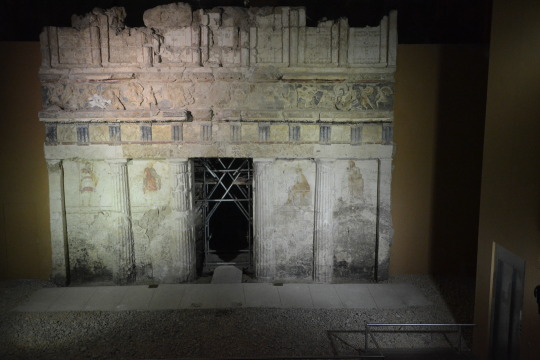
A “Macedonian Tomb” (above: Tomb of Judgement, photo mine) is a faux-shrine embedded in the ground. Elite families committed wealth to it in a huge potlatch to honor the dead. Earlier cyst tombs show the same proclivities, but without the accompanying shrine-like architecture. As early as 650 BCE at Archontiko (= ancient Pella), we find absurd amounts of wealth in burials (below: Archontiko burial goods, Pella Museum, photos mine). Same thing at Sindos, and Aigai, in roughly the same period. Also in a few places in Upper Macedonia, in the Archaic Age: Aiani, Achlada, Trebenište, etc.. This is just the tip of the iceberg. If Greece had more money for digs, I think we’d find additional sites.
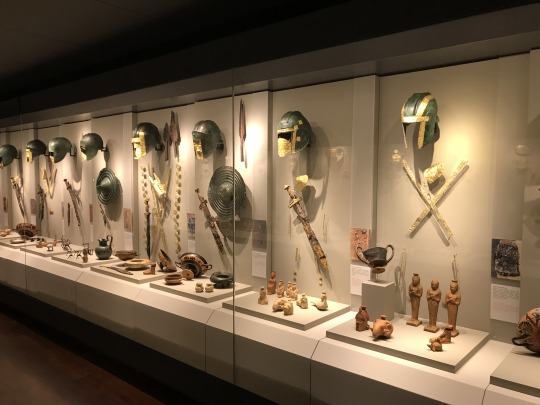

Vivi Saripanidi has some great articles (conveniently in English) about these finds: “Constructing Necropoleis in the Archaic Period,” “Vases, Funerary Practices, and Political Power in the Macedonian Kingdom During the Classical Period Before the Rise of Philip II,” and “Constructing Continuities with a Heroic Past.” They’re long, but thorough. I recommend them.
What we observe here are “Princely Burials” across lingo-ethnic boundaries that reflect a larger, shared regional culture. But one big difference between elite tombs in Macedonia and Thrace is the presence of a BODY, and whether the tomb was new or repurposed.
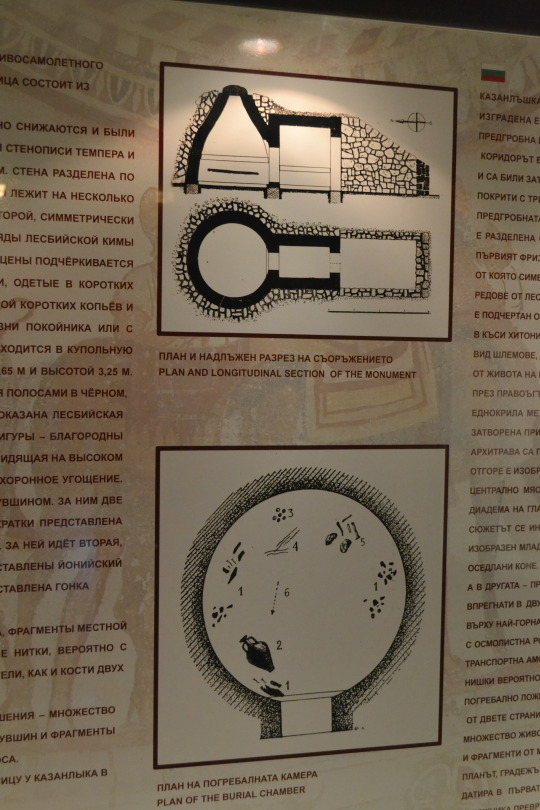

In Thrace, at least royal tombs are repurposed shrines (above: diagram and model of repurposed shrine-tombs). Macedonian Tombs were new construction meant to look like a shrine (faux-fronts, etc.). Also, Thracian kings’ bodies weren’t buried in their "tombs." Following the Dionysic/ Orphaic cult, the bodies were cut up into seven pieces and buried in unmarked spots. Ergo, their tombs are cenotaphs (below: Kosmatka Tomb/Tomb of Seuthes III, photos mine).

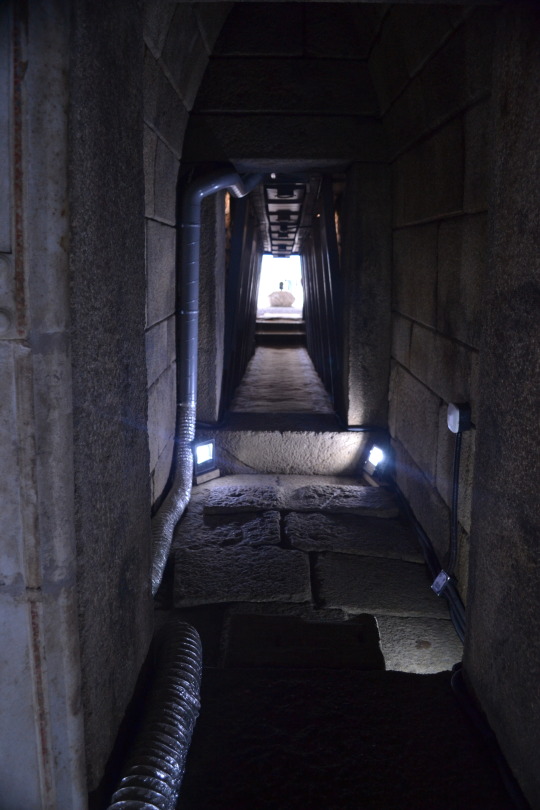
What they shared was putting absurd amounts of wealth into the ground in the way of grave goods, including some common/shared items such as armor, golden crowns, jewelry for women, etc. All this in place of community-reflective temples, as seen in the South. (Below: grave goods from Seuthes’ Tomb; grave goods from Royal Tomb II at Vergina, for comparison).



So, if some things are shared, others (connected to beliefs about the afterlife) are distinct, such as the repurposed shrine vs. new construction built like a shine, and the presence or absence of a body (below: tomb ceiling décor depicting Thracian deity Zalmoxis).

Aside from graves, we also find differences between highlands and lowlands in the roles of at least elite women. The highlands were tough areas to live, where herding (and raiding) dominated, and what agriculture there was required “all hands on deck” for survival. While that isn’t necessary for women to enjoy higher status (just look at Minoan Crete, Etruria, and even Egypt), it may have contributed to it in these circumstances.
Illyrian women fought. And not just with bows on horseback as Scythian women did. If we can believe Polyaenus, Philip’s daughter Kyanne (daughter of his Illyrian wife Audata) opposed an Illyrian queen on foot with spears—and won. Philip’s mother Eurydike involved herself in politics to keep her sons alive, but perhaps also as a result of cultural assumption: her mother was royal Lynkestian but her father was (perhaps) Illyrian. Epirote Olympias came to Pella expecting a certain amount of political influence that she, apparently, wasn’t given until Philip died. Alexander later observed that his mother had wisely traded places with Kleopatra, his sister, to rule in Epiros, because the Macedonians would never accept rule by a woman (implying the Epirotes would).
I’ve noted before that the political structure in northern Greece was more of a continuum: Thessaly had an oligarchic tetrarchy of four main clans, expunged by Jason in favor of tyranny, then restored by Philip. Epiros was ruled by a council who chose the “king” from the Aiakid clan until Alexandros I, Olympias’s brother, established a real monarchy. Last, we have Macedon, a true monarchy (apparently) from the beginning, but also centered on a clan (Argeads), with agreement/support from the elite Hetairoi class of kingmakers. Upper Macedonian cantons (formerly kingdoms) had similar clan rule, especially Lynkestis, Elimeia, and Orestis. Alas, we don’t know enough to say how absolute their monarchies were before Philip II absorbed them as new Macedonian districts, demoting their basileis (kings/princes) to mere governors.
I think continued highland resistance to that absorption is too often overlooked/minimized in modern histories of Philip’s reign, excepting a few like Ed Anson’s. In Dancing with the Lion: Rise, I touch on the possibility of highland rebellion bubbling up late in Philip’s reign but can’t say more without spoilers for the novel.
In antiquity, Thessaly was always considered Greek, as was (mostly) Epiros. But Macedonia’s Greek bona-fides were not universally accepted, resulting in the tale of Alexandros I’s entry into the Olympics—almost surely a fiction with no historical basis, fed to Herodotos after the Persian Wars. The tale’s goal, however, was to establish the Greekness of the ruling family, not of the Macedonian people, who were still considered barbaroi into the late Classical period. Recent linguistic studies suggest they did, indeed, speak a form of northern Greek, but the fact they were regarded as barbaroi in the ancient world is, I think instructive, even if not necessarily accurate.
It tells us they were different enough to be counted “not Greek” by some southern Greek poleis and politicians such as Demosthenes. Much of that was certainly opportunistic. But not all. The bias suggests Macedonian culture had enough overflow from their northern neighbors to appear sufficiently alien. Few Greek writers suggested the Thessalians or Epirotes weren’t Greek, but nobody argued the Thracians, Paiones, or Illyrians were. Macedonia occupied a liminal status.
We need to stop seeing these areas with hard borders and, instead, recognize permeable boundaries with the expected cultural overflow: out and in. Contra a lot of messaging in the late 1800s and early/mid-1900s, lifted from ancient narratives (and still visible today in ultra-national Greek narratives), the ancient Greeks did not go out to “civilize” their Eastern “Oriental” (and northern barbaroi) neighbors, exporting True Culture and Philosophy. (For more on these views, see my earlier post on “Alexander suffering from Conqueror’s Disease.”)
In fact, Greeks of the Late Iron Age (LIA)/Archaic Age absorbed a great deal of culture and ideas from those very “Oriental barbarians,” such as Lydia and Assyria. In art history, the LIA/Early Archaic Era is referred to as the “Orientalizing Period,” but it’s not just art. Take Greek medicine. It’s essentially Mesopotamian medicine with their religion buffed off. Greek philosophy developed on the islands along the Asia Minor coast, where Greeks regularly interacted with Lydians, Phoenicians, and eventually Persians; and also in Sicily and Southern Italy, where they were talking to Carthaginians and native Italic peoples, including Etruscans. Egypt also had an influence.
Philosophy and other cultural advances didn’t develop in the Greek heartland. The Greek COLONIES were the happenin’ places in the LIA/Archaic Era. Here we find the all-important ebb and flow of ideas with non-Greek peoples.
Artistic styles, foodstuffs, technology, even ideas and myths…all were shared (intentionally or not) via TRADE—especially at important emporia. Among the most significant of these LIA emporia was Methone, a Greek foundation on the Macedonian coast off the Thermaic Gulf (see map below). It provided contact between Phoenician/Euboian-Greek traders and the inland peoples, including what would have been the early Macedonian kingdom. Perhaps it was those very trade contacts that helped the Argeads expand their rule in the lowlands at the expense of Bottiaians, Almopes, Paionians, et al., who they ran out in order to subsume their lands.
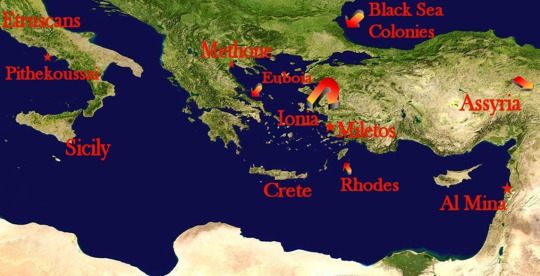
My main point is that the northern Greek mainland/southern Balkans were neither isolated nor culturally stunted. Not when you look at all that gold and other fine craftwork coming out of the ground in Archaic burials in the region. We’ve simply got to rethink prior notions of “primitive” peoples and cultures up there—notions based on southern Greek narratives that were both political and culturally hidebound, but that have, for too long, been taken as gospel truth.
Ancient Macedon did not “rise” with Philip II and Alexander the Great. If anything, the 40 years between the murder of Archelaos (399) and the start of Philip’s reign (359/8) represents a 2-3 generation eclipse. Alexandros I, Perdikkas II, and Archelaos were extremely capable kings. Philip represented a return to that savvy rule.
(If you can read German, let me highly recommend Sabine Müller’s, Perdikkas II and Die Argeaden; she also has one on Alexander, but those two talk about earlier periods, and especially her take on Perdikkas shows how clever he was. For those who can’t read German, the Lexicon of Argead Macedonia’s entry on Perdikkas is a boiled-down summary, by Sabine, of the main points in her book.)
Anyway…I got away a bit from Thracian-Macedonian cultural parallels, but I needed to mount my soapbox about the cultural vitality of pre-Philip Macedonia, some of which came from Greek cultural imports, but also from Thrace, Illyria, etc.
Ancient Macedonia was a crossroads. It would continue to be so into Roman imperial, Byzantine, and later periods with the arrival of subsequent populations (Gauls, Romans, Slavs, etc.) into the region.
That fruit salad with Cool Whip, or Jello and marshmallows, or chopped up veggies and mayo, that populate many a family reunion or church potluck spread? One name for it is a “Macedonian Salad”—but not because it’s from Macedonia. It’s called that because it’s made up of many [very different] things. Also, because French macedoine means cut-up vegetables, but the reference to Macedonia as a cultural mishmash is embedded in that.
---------------
* I’ve seen this personally between my first trip to Greece in 1997, and the new modern highway. Instead of winding around mountains, the A2 just blasts through them with tunnels. The A1 (from Thessaloniki to Athens) was there in ’97, and parts of the A2 east, but the new highway west through the Pindus makes a huge difference. It takes less than half the time now to drive from the area around Thessaloniki/Pella out to Ioannina (near ancient Dodona) in Epiros. Having seen the landscape, I can imagine the difficulties of such a trip in antiquity with unpaved roads (albeit perhaps at least graded). Taking carts over those hills would be daunting. See images below.

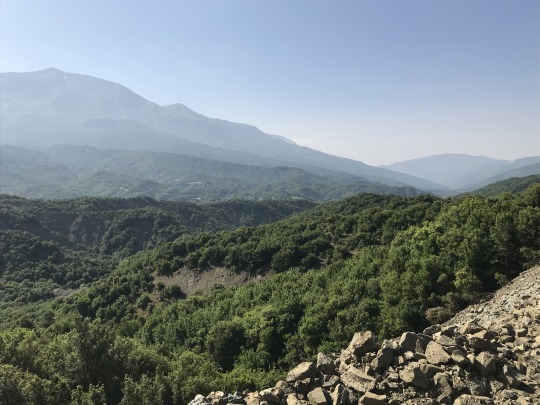
#asks#ancient Macedonia#ancient Thrace#ancient Epiros#ancient Thessaly#Argead Macedonia#pre-Philip Macedonia#Late Iron Age Greece#Archaic Age Greece#Thracian tombs#Macedonian tombs#Classics#tagamemnon#Alexander the Great#Philip II of Macedon#Philip of Macedon#women in ancient Macedonia#ancient Illyria#women in Illyria#Macedonian-Thracian similarities#religion in ancient Thrace#religion in ancient Macedonia
13 notes
·
View notes
Note
what’s a controversial take that you’re afraid to share on tumber dot com
i dont care that you broke your elbow
#hmmmm#lately i feel like a lot of the terms we use in modern psychology are going to be archaic sooner than later#like i think we are learning how to treat symptoms but do i think people are going to be saying they have like anxiety and depression in the#near future like as a disease... no#i dont thnk we have any idea whats going on up there are the way we diagnose mental illnesses is stupid#but im not an expert you just asked for a dumb opinion basically so xo
6 notes
·
View notes
Text
365 Days of Writing Prompts: Day 331
Adjective: Old-Fashioned
Noun: Posy
Definitions for those who need/want them:
Old-Fashioned: in or according to styles or types no longer current or common, or not modern; (of a person or their views) favoring traditional and usually restrictive styles, ideas, or customs
Posy: a small bunch of flowers; (archaic) a short motto or line of verse inscribed inside a ring
#hello yes i am late again#i would have been earlier (not on time but earlier) but i lay down on the couch a bit ago and fell asleep on accident#just like i did last night#(except that was in bed that time)#my day wasnt too busy or anything but i did sort a lot of our new and old magic cards#i also worked on an art piece and looked at some jobs#(im still waiting to hear back about a few but i dont want to risk ending up not getting a job with one of them if i just keep waiting)#my girlfriend and i also watched more orphan black#i suspect we will finish this season within a week (especially since we only have six episodes left atm)#im excited to see what my girlfriend think about the following episodes#anyway this is another rather straightforward prompt#but like (i think) ive said before sometimes those are the most fun to work with#also i had no idea about the archaic definition of 'posy' and i love archaic definitions especially this one#so i think i may look at that one for my poem#however im planning on taking 'old-fashioned' in a antique or heirloom type of direction regardless of how i interpret 'posy'#im interested in and excited about exploring all of that#thanks for reading#writing#writer#creative writing#writing prompt#writeblr#trying to be a writeblr at least#*thinks
5 notes
·
View notes
Note
OH i forgot 2 update you but i DID write a paper on your art for class (twas the celestia's burden piece with zhongli) and i got an a (yay!!) but i cannot find the assignment now???? it was just about like ownership n context and stuff of like how it would be different to someone familiar to genshin to someone who isnt etc :thumbs_up:
THATS SO COOL 😭😭😭😭 I would love to read it if you ever find it again but omg I love that so much…. Thank you for writing about my art AND CONGRATULATIONS YOU DESERVE THE A!!!
#that’s so cool omg#also sorry for the late response I replied to this in my head and then forgot#anonymous#ask the archaic
4 notes
·
View notes
Text


bro who is editing the wiki "extremely archaic and primitive" it is literally described in game as a childs toy. it is sporting equipment. is this shit written in-character by an rda archaeologist. i am about to start describing real world lacrosse this way
#lacrosse was an extremely archaic and primitive sport played during the late american empire by a juvenile warrior caste called 'jocks'#its also the same as a tennis ball thrower#'archaic and primitive' WE STILL USE THESE IN REAL.
0 notes
Text
So I was thinking abt like what time period my cotl canon is
Originally I was gonna do like 1900s-1910s/1920s but then I thought of like an 100 years later thing for my canon and it’d be sorta weird to have it take place in the 2000s even with the hc that the lands of old faith is outdated tech wise ( though it does catch up a bit when solange actually visits outside of the lands of old faith and implements the tech there to her community )
But I don’t rlly think it takes place before at minimum the mid/late 1800s so I’m wondering if I should just do some weird ass fantasy time soup thingy where the lands of old faith is currently pretty behind tech wise ( think like shrek universe but a tad more modern in some areas ) while most of the world outside is more modern tech wise ( like a sorta mishmash between the 1900s and 1910s with high fantasy elements along with a few things that are more “modern” ( ie more effective birth control )
#idk why I’m overthinking this help me pls#idk what y’all think?#did the devs ever give like a sort of time frame for cotl bc it’s very confusing tbh#like it’s pretty archaic but there’s also things that were invented in like the late 1800s up to like 1920s#id like to hear how you interpret this weird time soup thing#I thought Psychonauts was pretty complicated with how time soupy it is but damn cotl is a lot more confusing#cult of the lamb#cosmic chatz
1 note
·
View note
Text
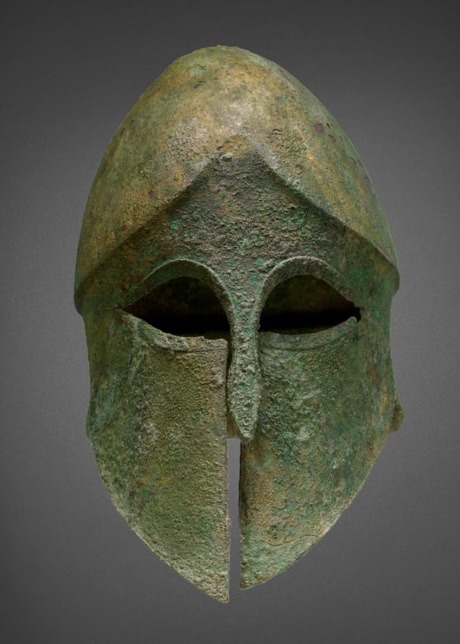


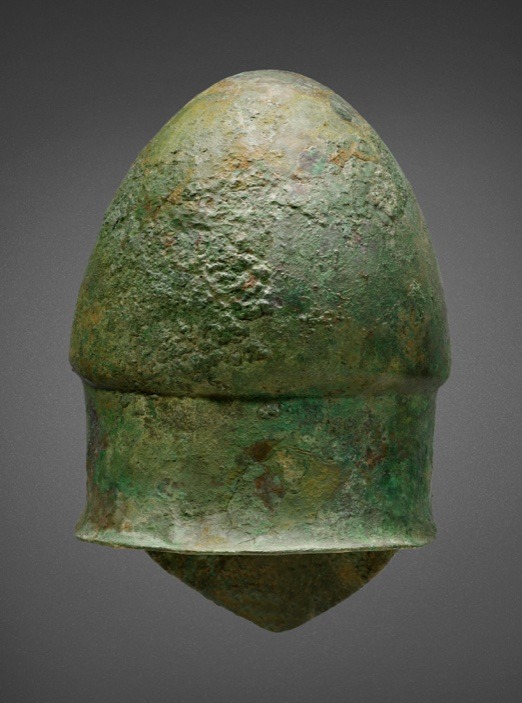
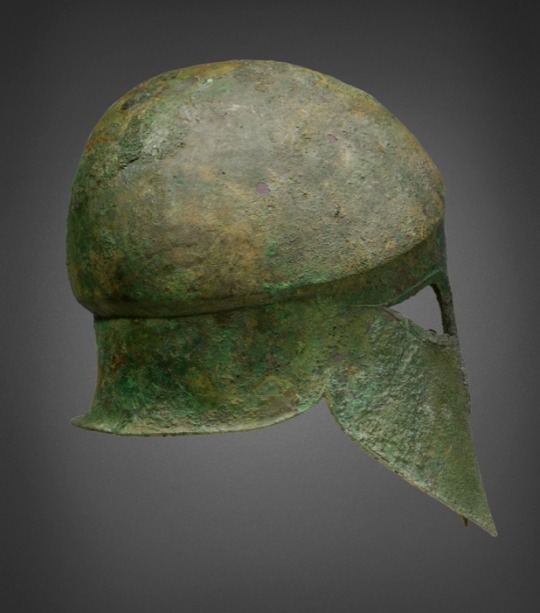

A GREEK BRONZE CORINTHIAN HELMET LATE ARCHAIC TO EARLY CLASSICAL PERIOD, CIRCA 525-475 B.C.
#A GREEK BRONZE CORINTHIAN HELMET#LATE ARCHAIC TO EARLY CLASSICAL PERIOD#CIRCA 525-475 B.C.#bronze#bronze helmet#military equipment#ancient artifacts#archeology#archeolgst#history#history news#ancient history#ancient culture#ancient civilizations#ancient greece#greek history
217 notes
·
View notes
Text
bereft in a word balloon
0 notes
Text
Intriguing ‘Dionysus with Panther’ Chariot Applique Discovered in Bulgaria’s Skutare in Settlement Inhabited in Ten Different Periods
A likely chariot bronze applique showing ancient deity Dionysus with a panther (leopard) has been discovered at the prehistoric, Antiquity, and medieval settlement at Bulgaria’s Skutare near Plovdiv. Photo by lead archaeologist Elena Bozhinova, Plovdiv Museum of Archaeology A highly intriguing ancient artifact – a bronze applique depicting wine god Dionysus together with what is believed to be a…
#Ancient Rome#Ancient Thrace#Ancient Thracians#Antiquity#applique#appliques#Archaic Period#Bronze Age#bronze applique#Bulgarian Archaeology exhibition#Byzantine Empire#Byzantium#Chalcolithic#chariot#chariot applique#Classical Period#coin#coins#Copper Age#Dionysus#Early Iron Age#Early Middle Ages#Eastern Roman Empire#Elena Bozhinova#excavations#Iron Age#Late Bronze Age#leopard#Middle Ages#Middle Bronze Age
0 notes
Text
look at this tiny tiny ancient depiction of a goose sheltering babies beneath her wings. 🥺
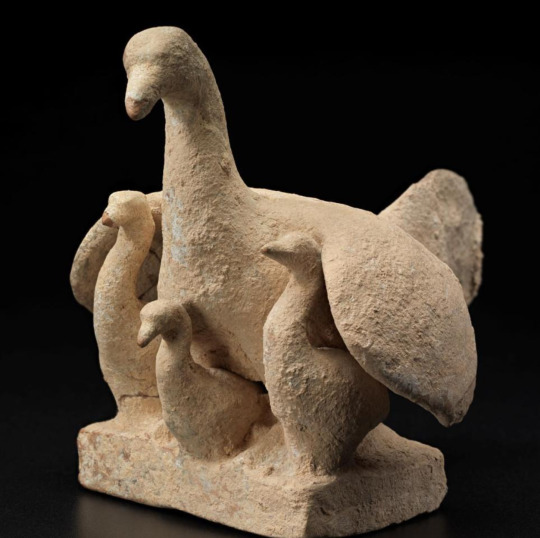
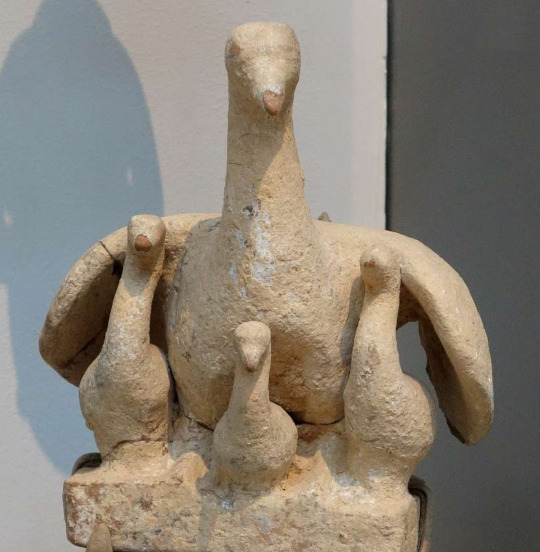
it's not very detailed but look at the postures of the animals. And the way the goslings are not very young but recognisable as gangly and halfway grown.
Greek, Late Archaic Period, about first half of 5th century B.C.
29K notes
·
View notes
Text
the usage of different types of english in elden ring
most human/tarnished NPCs we meet, like rogier, ansbach, and nepheli, use late modern english:
"a sorcerer, as you might have guessed. i'm looking for a little something, here in the castle. when i'm not hotfooting it from the troops, that is." - rogier, first meeting "general radahn. a pleasure to see you, after all this time. but those remains do not belong to you." - ansbach, upon summon for PCR
but older demigods like messmer, ranni, and morgott use early modern english:
"thou'rt tarnished, it seemeth. mother, wouldst thou truly lordship sanction, in one so bereft of light? yet… my purpose standeth unchanged." - messmer, pre-battle cutscene "thou needst not indulge them unduly, but they too wish to appraise thy worth. it hath been a passing long time since a newcomer entered my service, after all." - ranni, after agreeing to serve her
then there are the younger demigods, like miquella, malenia, and potentially melina, who use a later variant of modern english, similar to the tarnished NPCs we speak to:
"if we honour our part of the vow, promise me you'll be my consort. i'll make the world a gentler place." - miquella, post-PCR cutscene "the scarlet bloom flowers once more. you will witness true horror. now, rot!" - malenia, phase 2 transition cutscene
finally, the hornsent NPCs like the hornsent, hornsent grandam, and the hornsent spirits such as the one outside the whipping hut, who use late middle english similar to the english found in shakespeare's sonnets:
"fie, another? ... then, as that woman would surely say, we are in our purposes well aligned. but understand. your kind are not forgiven. the erdtree is my people's enemy. by marika long betray'd, set aflame." - hornsent, first meeting "all your resentment lingers yet... the raw stuff from which i shall surely forge a curse. upon the dastard messmer's head. upon marika's children each and all." - scorched ruins hornsent spirit
i find it interesting how different the usage of english is in the game, and i feel that it can be a hint on how to properly date an individual's occupation in the lands between/land of shadow. the hornsent, being a people much older than many in the lands between, use the most archaic version of english, while the tarnished and younger demigods use a form of english more closely related to our own in the current period. older demigods (and marika herself, as heard from melina's recounts of marika's spoken echoes) use a form of english more closely related to the period of transition from middle english to early modern english.
additionally, another interesting thing to me: mohg is almost certainly nearly the same age as morgott (since they're referred to as twins), yet he speaks a little differently compared to morgott:
"tarnished, thou'rt but a fool." - morgott, post-battle dialogue "dearest miquella. you must abide alone a while." - mohg, pre-battle cutscene
this makes me wonder if it's possible that, assuming that miquella's verbiage is indicative of his younger age in comparison to the older demigods (aka the demigods born before the marika/radagon union), miquella's charm altered mohg's perception enough to also alter his manner of speaking and carrying himself in some way. if his pursuit of finery (dressing in embroidered robes and handling himself with poise, juxtaposing his bestial growls and strength) was mainly done in an effort to fit into miquella's ideal of a consort. of course, mohg could just be as vain as he seems to be all on his own accord, but i find that it's interesting to entertain the idea that even his current state of being was due to miquella's charm.
i'd love to hear what others think about this. i'm not very learned when it comes to english (it's not really my first language), but i find this all very cool to think about.
#elden ring#elden ring rambles#elden ring lore#shadow of the erdtree#sorcerer rogier#sir ansbach#messmer the impaler#messmer#ranni the witch#lunar princess ranni#miquella the kind#miquella#malenia blade of miquella#malenia#hornsent#morgott the omen king#morgott#margit the fell#mohg lord of blood#mohg#omenboys#chadsbach
1K notes
·
View notes